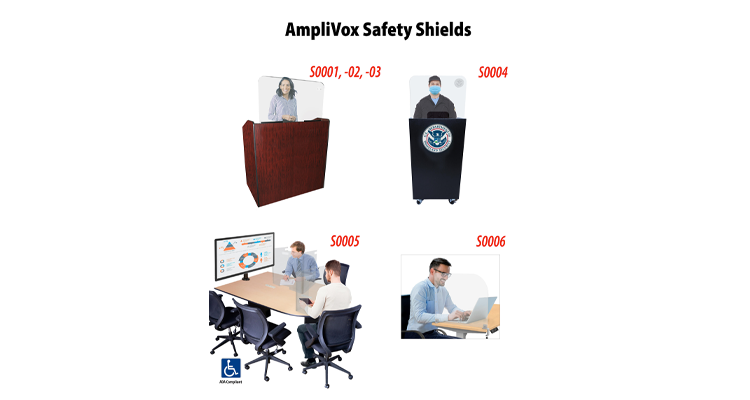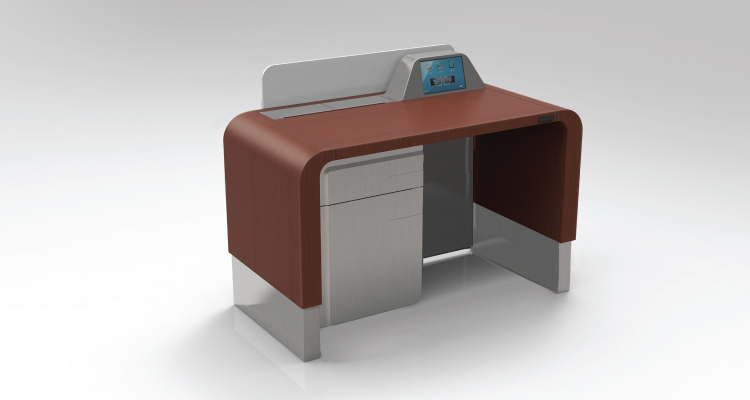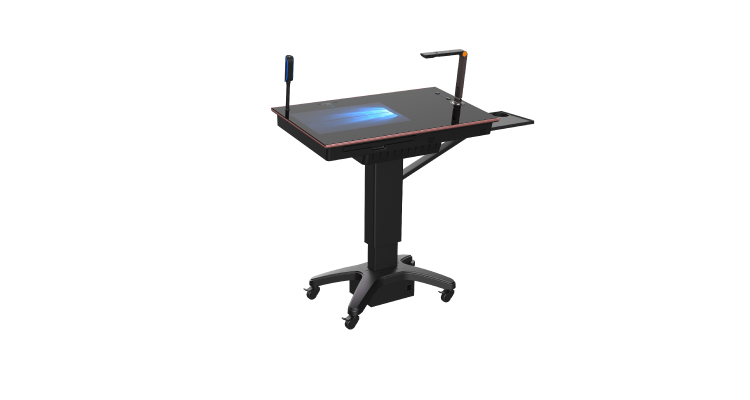Behind the AV Lectern
While this article features two lectern companies, it’s really about all lecterns. The author has no commercial involvement with any of the companies mentioned in this article.
There it is, always on stage. Standing on a podium for so long and so often, some of the users even call it a podium. But it’s not a podium, it’s a lectern.
For years it was made of wood, a dumb block. It stood in front of us in church, at military ceremonies, in university lectures, in conference halls, at our courts of law and at press conferences.
While the users have not changed, the potential uses of a lectern have multiplied.
Driven by the advent of presentation technology, the humble lectern has a city cousin: the digital lectern whose family branch includes the very intelligent multi-taskers as well as the ones who do nothing but hold the microphone for the speaker.
With technology, corporates have joined the list of the main user groups of lecterns, a welcome addition as companies (more than churches or universities) spend on technology to impress customers, suppliers and even employees.
The “dumb wood” lectern is still out there, holding its own against the digital transformation in a way the compact disc would never understand. Some buy the wood lectern for the low price, while others prefer more expensive hand-made or custom models for exuding a natural ambiance (often required in a traditional wood-built environment).
When wood is chosen after consideration and in coordination with its ultimate environment, it’s a natural choice. When it’s chosen for price and dropped into a modern environment, at best it’s a jarring statement that shows no appreciation for the content and presenters. At worst, it sometimes is a chip off the Luddite block.
Today wood or laminate models sell for as low as 20-120€ (unless custom- or hand-made) while acrylic (as low as 90- 300€), stainless steel and aluminum (both selling usually in the 3000-12,000€) are the other primary lectern materials.
While wood (and composites) remains the major cost factor in the lectern at the low end, in the high end, the material cost becomes less of a percent of the total price as it’s all about the extra technology and add-ons.
There are even a few lecterns made of concrete, usually in buildings known for their “Brutalist” architectural style, a modern look characterized by raw, exposed concrete and bold geometric form. Some folks question these lecterns by asking “Do you know how hard it is to move a concrete lectern?” But that’s the point of this particular lectern. It’s meant to look and to be immutable. After all, symbiotic with its environment a lectern must be a follower not a leader. (Et tu, lecternus?)
There are more than a hundred of lectern makers in Europe, plus almost 200 or so from China selling to EMEA (shown as exporters in Global Sources), and another 100+ in USA (listing on Thomas Register.)
On the high end, an architectural sourcing site like Archiexpo identifies only 34 manufacturers (with 94 models available). Inclusion seems to be accidental more than a stamp of approval.
rAVe Europe interviewed two manufacturers of lecterns to talk about today’s business. Both address the mid-to high range (3000-7000€), yet each takes a very different approach to the market.
Both seem to be on a path to the future of the lectern, a journey that doesn’t exclude a third path for the wooden lectern that will probably last as long as there is still wood.
Heckler Design, Earning “Graduate Degrees” in Design
Based in Arizona, Heckler Design is a manufacturer that leverages its Designed-and-Made-in-America heritage. Heckler Design creates modern AV hardware, furniture and video meeting solutions — a range of products such as AV carts, wall mounts, iPad stands, video meeting camera mounts and accessories, and — of course — AV lecterns.
(Check out the company’s new custom covers for Logitech’s Rally Bar Huddle.)
Heckler Design is named after the CEO (which avoids explaining the irony of “heckler” for a company making solutions for presenters.)
Design is more than just another word in their company name. With an artisan mentality, design is such an important part of their DNA they can declare believably their company motto, “Protect the world from boring hardware.”
That’s got to be the second-best corporate motto after “Do no evil.”
“Almost everything here started out as a custom project,” explains Neal Weber, CTS, director of business development at Heckler Design. In the case of lecterns, Heckler Design heard a common user theme: “It’s so hard to manage technology in a small footprint.” Often installers would complain about access to the technology at the lectern, how difficult it was to change or adapt.
“Lecterns,” said Weber, “often ended up looking like Frankenstein.”
Apparently even the most hallowed of places for a lectern suffer from lectern failure issues. Check out this visit to America’s White House lectern.
@greazywilmusic #whitehouse #audio #tour #greazywil #music #engineer #cablemanagement #government ♬ original sound – GreazyWil
It’s those darn cables. Lecterns can be a bear trap of wires for presenters who are looking forward at an audience instead watching where they step.
Heckler Design lecterns distinguish themselves with cable management, clean lines, minimalist design and versatility.
The company’s lecterns (cold-rolled steel and powder-coated white-black-or-gray aluminum) accommodate a wide range of audiovisual components, including media players, sound bars and cable management systems.
Models are pleasantly modular off a singular chassis design. We’re talking about up to 6U rack spaces below a work surface. These lecterns are built with AV in mind, with a lot of thought about the AV/IT techs who have to install and maintain them.


.jpg)
It’s easy to love the clips that manage the cables down the lectern legs or the cable-pass-through perforated mesh (runs between the tech interfaces on top to the technology you need below.)
Adjustable shelves, assisted lifts, cable management channels: You don’t have to be Marie Kondo to understand the value of de-cluttering the modern, digitally enabled lectern. After all, in IT terms, what is a lectern but a workstation?
These workstations have the Heckler Design advantage of input from one of the largest lectern user groups: classroom tech managers at universities. The AV departments of 12 significant American universities have regular input — and Heckler has the only Higher Education Technology Managers Alliance (HETMA)-approved lectern. (HETMA is led by the inimitable Joe Way, known to many of us in the AV industry.)
With that collegiate input (call it “a graduate degree in education”), it’s no wonder Heckler Design lecterns come with antimicrobial surfaces, modesty panels, useful desktop receptacles, standard casters, adjustable height — and even cup holders.
The key features of Heckler Design include:
- Minimalist design: You get clean lines and a modern look that works in most environments. It’s positively utilitarian (in the way American design style embraces the practical.)
- Smart AV component mounting: An impressive amount of smart mounting options, blessedly built for easy installation, repair, and upgrading (when necessary).
- Versatility and customization: Comes in various sizes and finishes, allowing users to choose for their specific needs and style preferences. You can add your logo and a future model will allow dynamic signage on the front.
- Durable yet sustainable construction: Built to last but also reduces waste and promotes sustainability.
Intelligent Lectern Systems: The Digital Presenter

Based in Netherlands, Intelligent Lectern Systems (ILS) launched in 2006 — in reaction to a lectern market that focused more on the control of the environment than supporting the presenter. ILS builds easy-to-use appliance-like digital lectern solutions with small footprints, using advanced metals and structural materials.
Almost all ILS systems include large touch displays and come with software that helps the presenter with his delivery as well providing easy navigation and quick switching between presentations and more digital aids.
Henk De Groot, owner of ILS, began his career at Tektronix, developing graphics display systems. Then, in 1991, he ran InFocus as managing director for EMEA for eight years. And he had two more years as sales director at Boxlight for EMEA.
Then he saw The Opportunity — well, what he really saw was that the market for lecterns had mostly just embedded small displays in wooden cabinets. Awkward! The market needed something … something much more modern. And digital.
While some of the lecterns offer extensions for notes (or document cameras), these lecterns embrace the digital age. You can buy a few models without the computer displays (bring your own) — but, at ILS, the presenter is Master and Commander, the captain at the wheel of a digital ship sailing the content seas.
Most of the ILS lecterns are T-shape stations on caster bases with adjustable height and computer-driven tops. Some offer integrated half racks and others full racks. Some are more presidential and there’s even a teacher desk model.
The solid top of the ILS lectern is usually placed on a motorized narrow pillar with a height adjustment range up to 40 cm (15”+). Buttons help you to control height, and in the lowest position, even a seated person can use the system.
Usually, a holder for the micro PC is installed inside the working surface, and the integrated VESA mount allows the installation of a monitor up to 27 inches. There are shock mounts for quality microphones. Depending upon the model, the lectern could have one or two horizontal side tables (able to move up or down with the top).
The built-in switcher or sockets (the amount and type on request) will be great helpers when handling connections between the main screen of the lectern and/or laptop, or other devices. Buttons on the top panel act as control.
The models are thoughtful about connectivity, offering USB 3.0 sockets and some models with a holder with built-in charging cables for tablets and smartphones. A keyboard tray can be integrated.
The average sale is about 7000€ and the buyers are from corporate, education, military, nursing, training, insurance and others. These institutions can have their logo on the extra front panel of the lectern, engraved by ILS.
ILS makes all their products in the Netherlands (obviously with parts from across the globe), even grinding the powder for the modern coating.

The lecterns are high-end and built to protect the investment. There’s no attention required, and often ILS doesn’t hear from a customer for years, until they need to add a few more models or upgrade from 1K to 4K, from screen to touch screen. Orders can often be about 200 lecterns from big corporate customers like oil companies or universities, with additional orders coming in from time to time.
The key features of ILS lecterns include:
- Intelligent lecterns: It’s all about the smarts, the quality components, the digital connectivity, and the options for extra switching gear. Today’s presenters need to be masters of their digital content.
- Modern design: Metal bastions of presentation, the T-shape is the Mr. T of the ILS A-Team. Styling with aluminum and powder coating adds the Mr. T bling.
- Customization: Various configurations allow lots of choice, depending upon if you are a lecturer or a captain of industry. You can go half rack or full rack. You can add your logo for impact.
- The digital vision: ILS draws on its heritage in the display business, making the display for the speaker of equal importance to the audience display. With 120Hz and 144Hz refresh rates for improving pen interactivity, ILS is bringing higher frequencies to the lectern.
Summary Notes on the Lectern
While large corporates and prestige institutions understand both the image and the productivity of the modern lectern, there’s still huge opportunity in the market. Any career in speaking brings you to conferences, trade shows and business venues where the lectern is still only furniture — where the cable jungle runs rampant at your feet and the lectern top is unfriendly to computers. Apple users are asked if they brought their own cables. And speakers are heard talking to the technical team at the back of the room, “Next slide, please?” Or “The video doesn’t work.”
Some of this is fed by the AV companies that are hired to add professional video and sound. They set up in the back of the room and run their area like a clubhouse. They prefer all control centralized (in their hands) and seem oblivious to the quality of lecterns that are dragged out. Not their problem. In fact, it’s a plus for them if the lectern can’t even hold a computer.
But those days are coming to an end. Like many industries, the battle for control is moving to the user. They need last minute changes, the ability to shift content gears ad hoc, and even (God forbid) digress from the previously programmed show. Supported by their institutions, the speakers need to have creative control for impact, for leveraging the exploding impact of social media formats, for integrating content form with technological function.
The service offer is changing. The new need is for AV companies who control the experience, not the content. We are now content-enablers, not the presentation police.
This trend won’t eliminate the role of AV event services, but it will push some integrators who sell the technology into taking the new role away from event AV companies. For similar reasons, event companies are already expanding into systems integration.
And all major lectern companies seem to be targeting one price-level down, trying to build models in the sweet spot about half of today’s average price for premium lecterns.
Heckler Design
Heckler (hecklerdesign.com)
Intelligent Lectern Systems (ILS)
https://www.intelligentlecterns.com/
How the political lectern reflects the UK politician … Oliver Wainwright writing in The Guardian newspaper in UK
https://www.theguardian.com/artanddesign/2022/oct/25/new-pm-new-lectern-rishi-sunak
What do pastors preach amongst themselves about lecterns?
http://forum.ship-of-fools.com/cgi-bin/ultimatebb.cgi?ubb=print_topic;f=70;t=025827
How to make a lectern in Minecraft. Really.
https://minecraft.fandom.com/wiki/Lectern




